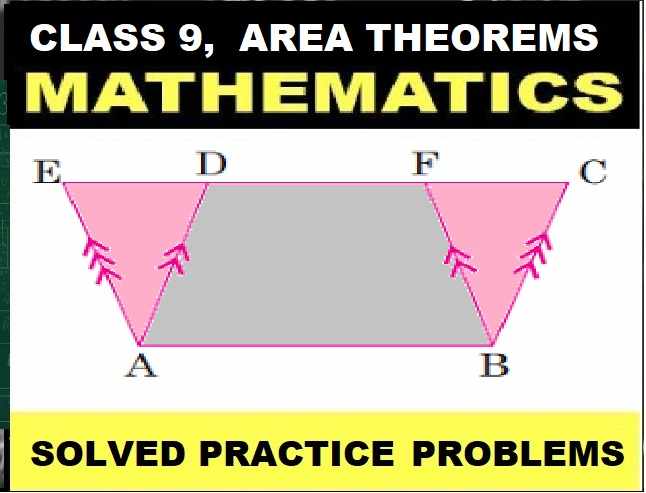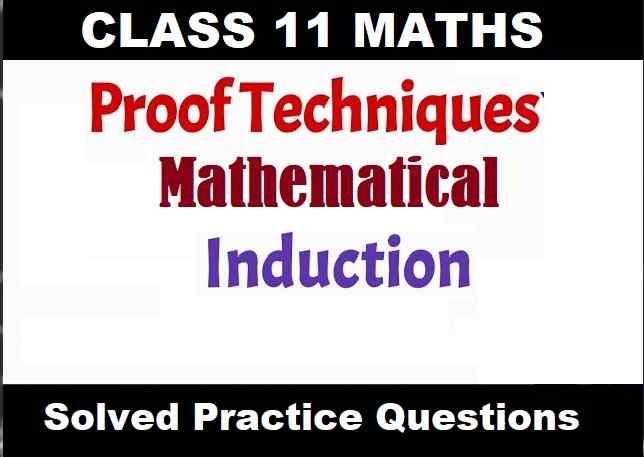ML Aggarwal Factorisation Exe-4.3 Class 9 ICSE Maths Solutions. Visit official website CISCE for detail information about ICSE Board Class-9.
ML Aggarwal Factorisation Exe-4.3 Class 9 ICSE Maths Solutions
| Board | ICSE |
| Subject | Maths |
| Class | 9th |
| Chapter-4 | Factorisation |
| Topics | Solution of Exe-4.3 Questions |
| Academic Session | 2024-2025 |
Solution of Exe-4.3 Questions
ML Aggarwal Factorisation Exe-4.3 Class 9 ICSE Maths Solutions
Question 1.
(i) 4x2 – 25y2
(ii) 9x2 – 1
Answer :
(i) 4x2 – 25y2
We know that, a2 – b2 = (a + b) (a – b)
So, (2x)2 – (5y)2
Then, (2x + y) (2x – 5y)
(ii) 9x2 – 1
We know that, a2 – b2 = (a + b) (a – b)
So, (3x)2 – 12
Then, (3x + 1) (3x – 1)
Question 2.
(i) 150 – 6a2
(ii) 32x2 – 18y2
Answer :
(i) 150 – 6a2
Take out common in all terms,
6(25 – a2)
6(52 – a2)
We know that, a2 – b2 = (a + b) (a – b)
So, 6(5 + a) (5 – a)
(ii) 32x2 – 18y2
32x2 – 18y2
Take out common in all terms,
2(16x2 – 9y2)
2((4x)2 – (3y)2)
We know that, a2 – b2 = (a + b) (a – b)
2(4x + 3y) (4x – 3y)
Question 3.
(i) (x – y)2 – 9
(ii) 9(x + y)2 – x2
Answer :
(i) (x – y)2 – 9
(x – y)2 – 32
We know that, a2 – b2 = (a + b) (a – b)
(x – y + 3) (x – y – 3)
(ii) 9(x + y)2 – x2
9[(x + y)2 – x2]
We know that, a2 – b2 = (a + b) (a – b)
9[(x + y + x) (x + y – x)]
So, 9(2x + y) y
9y(2x + y)
Question 4.
(i) 20x2 – 45y2
(ii) 9x2 – 4(y + 2x)2
Answer :
(i) 20x2 – 45y2
Take out common in all terms,
5(4x2 – 9y2)
5((2x)2 – (3y)2)
We know that, a2 – b2 = (a + b) (a – b)
5(2x + 3y) (2x – 3y)
(ii) 9x2 – 4(y + 2x)2
9x2 – 4(y + 2x)2
Above question can be written as,
(3x)2 – [2(y + 2x)]2
(3x)2 – (2y + 4x)2
We know that, a2 – b2 = (a + b) (a – b)
(3x + 2y + 4x) (3x – 2y – 4x)
(7x + 2y) (-x – 2y)
Question 5.
(i) 2(x – 2y)2 – 50y2
(ii) 32 – 2(x – 4)2
Answer :
(i) 2(x – 2y)2 – 50y2
Take out common in all terms,
2[(x – 2y)2 – 25y2]
2[(x – 2y)2 – (5y)2]
We know that, a2 – b2 = (a + b) (a – b)
2[(x – 2y + 5y) (x – 2y – 5y)]
2[(x + 3y) (x – 7y)]
2(x + 3y) (x – 7y)
(ii) 32 – 2(x – 4)2
32 – 2(x – 4)2
Take out common in all terms,
2[16 – (x – 4)2]
2[42– (x – 4)2]
We know that, a2 – b2 = (a + b) (a – b)
2[(4 + x – 4) (4 – x + 4)]
2[(x) (8 – x)]
2x (8 – x)
Question 6.
(i) 108a2 – 3(b – c)2
(ii) πa5 – π3ab2
Answer :
(i) 108a2 – 3(b – c)2
Take out common in all terms,
3[36a2 – (b – c)2]
3[(6a)2 – (b – c)2]
We know that, a2 – b2 = (a + b) (a – b)
3[(6a + b – c) (6a – b + c)]
(ii) πa5 – π3ab2
πa5 – π3ab2
Take out common in all terms,
πa(a4 – π2b2)
πa((a2)2 – (πb)2)
We know that, a2 – b2 = (a + b) (a – b)
πa(a2 + πb) (a2 – πb)
Question 7.
(i) 50x2 – 2(x – 2)2
(ii) (x – 2)(x + 2) + 3
Answer :
(i) 50x2 – 2(x – 2)2
Take out common in all terms,
2[25x2 – (x – 2)2]
2[(5x)2 – (x – 2)2]
We know that, a2 – b2 = (a + b) (a – b)
2[(5x + x – 2) (5x – x + 2)]
2[(6x – 2) (4x + 2)]
2(6x – 2) (4x + 2)
(ii) (x – 2)(x + 2) + 3
We know that, a2 – b2 = (a + b) (a – b)
(x2 – 22) + 3
X2 – 4 + 3
X2 – 1
Then,
(x + 1) (x – 1)
Question 8.
(i) x – 2y – x2 + 4y2
(ii) 4a2 – b2 + 2a + b
Answer :
(i) x – 2y – x2 + 4y2
x – 2y – (x2 + (2y)2)
We know that, a2 – b2 = (a + b) (a – b)
x – 2y – [(x + 2y) (x – 2y)]
Take out common in all terms,
(x – 2y) (1 – (x + 2y))
(x – 2y) (1 – x – 2y)
(ii) 4a2 – b2 + 2a + b
4a2 – b2 + 2a + b
(2a)2 – b2 + 2a + b
We know that, a2 – b2 = (a + b) (a – b)
((2a + b) (2a – b)) + 1(2a + b)
Take out common in all terms,
(2a + b) (2a – b + 1)
Question 9.
(i) a(a – 2) – b(b – 2)
(ii) a(a – 1) – b(b – 1)
Answer :
(i) a(a – 2) – b(b – 2)
Above question can be written as,
a2 – 2a – b2 – 2b
Rearranging the above terms, we get,
a2 – b2 – 2a – 2b
We know that, a2 – b2 = (a + b) (a – b)
[(a + b)(a – b)] – 2(a – b)
Take out common in all terms,
(a – b) (a + b – 2)
(ii) a(a – 1) – b(b – 1)
a(a – 1) – b(b – 1)
Above question can be written as,
a2 – a – b2 + b
Rearranging the above terms, we get,
a2 – b2 – a + b
We know that, a2 – b2 = (a + b) (a – b)
[(a + b) (a – b)] – 1 (a – b)
Take out common in all terms,
(a – b) (a + b – 1)
Question 10.
(i) 9 – x2 + 2xy – y2
(ii) 9x4 – (x2 + 2x + 1)
Answer :
(i) 9 – x2 + 2xy – y2
9 – x2 + 2xy – y2
Above terms can be written as,
9 – x2 + xy + xy – y2
Now,
9 – x2 + xy + 3x – 3x + 3y – 3y + xy – y2
Rearranging the above terms, we get,
9 – 3x + 3y + 3x – x2 + xy + xy – 3y – y2
Take out common in all terms,
3(3 – x + y) + x(3 – x + y) + y (-3 – y + x)
3(3 – x + y) + x(3 – x + y) – y(3 – x + y)
(3 – x + y) (3 + x – y)
(ii) 9x4 – (x2 + 2x + 1)
9x4 – (x2 + 2x + 1)
Above terms can be written as,
(3x2)2 – (x + 1)2 … [because (a + b)2 = a2 + 2ab + b2]
We know that, a2 – b2 = (a + b) (a – b)
So, (3x2 + x + 1) (3x2 – x – 1)
Question 11.
(i) 9x4 – x2 – 12x – 36
(ii) x3 – 5x2 – x + 5
Answer :
(i) 9x4 – x2 – 12x – 36
Above terms can be written as,
9x4 – (x2 + 12x + 36)
We know that, (a + b)2 = a2 + 2ab + b2
(3x2)2 – (x2 + (2 × 6 × x) + 62)
So, (3x2)2 – (x + 6)2
We know that, a2 – b2 = (a + b) (a – b)
(3x2 + x + 6) (3x2 – x – 6)
(ii) x3 – 5x2 – x + 5
x3 – 5x2 – x + 5
Take out common in all terms,
x2(x – 5) – 1(x – 5)
(x – 5) (x2 – 1)
(x – 5) (x2 – 12)
We know that, a2 – b2 = (a + b) (a – b)
(x – 5) (x + 1) (x – 1)
Question 12.
(i) a4 – b4 + 2b2 – 1
(ii) x3 – 25x
Answer :
(i) a4 – b4 + 2b2 – 1
Above terms can be written as,
a4 – (b4 – 2b2 + 1)
We know that, (a – b)2 = a2 – 2ab + b2
a4 – ((b2)2) – (2 × b2 × 1) + 12)
(a2)2 – (b2 – 1)2
We know that, a2 – b2 = (a + b) (a – b)
(a2 + b2 – 1) (a2 – b2 + 1)
(ii) x3 – 25x
x3 – 25x
Take out common in all terms,
x(x2 – 25)
Above terms can be written as,
x(x2 – 52)
We know that, a2 – b2 = (a + b) (a – b)
x(x + 5) (x – 5)
Question 13.
(i) 2x4 – 32
(ii) a2(b + c) – (b + c)3
Answer:
(i) 2x4 – 32
Take out common in all terms,
2(x4 – 16)
Above terms can be written as,
2((x2)2 – 42)
We know that, a2 – b2 = (a + b) (a – b)
2(x2 + 4) (x2 – 4)
2(x2 + 4) (x2 – 22)
2(x2 + 4) (x + 2) (x – 2)
(ii) a2(b + c) – (b + c)3
a2(b + c) – (b + c)3
Take out common in all terms,
(b + c) (a2 – (b + c)2)
We know that, a2 – b2 = (a + b) (a – b)
(b + c) (a + b + c) (a – b – c)
Question 14.
(i) (a + b)3 – a – b
(ii) x2 – 2xy + y2 – a2 – 2ab – b2
Answer:
(i) (a + b)3 – a – b
Above terms can be written as,
(a + b)3 – (a + b)
Take out common in all terms,
(a + b) [(a + b)2 – 1]
(a + b) [(a + b)2 – 12]
We know that, a2 – b2 = (a + b) (a – b)
(a + b) (a + b + 1) (a + b – 1)
(ii) x2 – 2xy + y2 – a2 – 2ab – b2
x2 – 2xy + y2 – a2 – 2ab – b2
Above terms can be written as,
(x2 – 2xy + y2) – (a2 + 2ab + b2)
We know that, (a + b)2 = a2 + 2ab + b2 and (a – b)2 = a2 – 2ab + b2
(x2 – (2 × x × y) + y2) – (a2 + (2 × a × b) + b2)
(x – y)2 – (a + b)2
We know that, a2 – b2 = (a + b) (a – b)
[(x – y) + (a + b)] [(x – y) – (a + b)]
(x – y + a + b) (x – y – a – b)
Question 15.
(i) (a2 – b2) (c2 – d2) – 4abcd
(ii) 4x2 – y2 – 3xy + 2x – 2y
Answer “
(i) (a2 – b2) (c2 – d2) – 4abcd
a2(c2 – d2) – b2 (c2 – d2) – 4abcd
a2c2 – a2d2 – b2c2 + b2d2 – 4abcd
a2c2 + b2d2 – a2d2 – b2c2 – 2abcd – 2abcd
Rearranging the above terms, we get,
a2c2 + b2d2 – 2abcd – a2d2 – b2c2 – 2abcd
We know that, (a + b)2 = a2 + 2ab + b2 and (a – b)2 = a2 – 2ab + b2
(ac – bd)2 – (ad – bc)2
(ac – bd + ad – bc) (ac – bd – ad + bc)
(ii) 4x2 – y2 – 3xy + 2x – 2y
4x2 – y2 – 3xy + 2x – 2y
Above terms can be written as,
x2 + 3x2 – y2 – 3xy + 2x – 2y
Rearranging the above terms, we get,
(x2 – y2) + (3x2 – 3xy) + (2x – 2y)
We know that, a2 – b2 = (a + b) (a – b) and take out common terms,
(x + y) (x – y) + 3x(x – y) + 2(x – y)
(x – y) [(x + y) + 3x + 2]
(x – y) (x + y + 3x + 2)
(x – y) (4x + y + 2)
Question 16.
(i) x2 + 1/x2 – 11
(ii) x4 + 5x2 + 9
Answer:
(i) x2 + 1/x2 – 11
Above terms can be written as,
x2 + (1/x2) – 2 – 9
Then, (x2 + (1/x2) – 2) – 32
We know that, (a – b)2 = a2 – 2ab + b2,
(x2 – (2 × x2 × (1/x2)) + (1/x)2)
(x – 1/x)2 – 32
We know that, a2 – b2 = (a + b) (a – b)
(x – 1/x + 3) (x – 1/x – 3)
(ii) x4 + 5x2 + 9
x4 + 5x2 + 9
x4 + 6x2 – x2 + 9
(x4 + 6x2 + 9) – x2
((x2)2 + (2 × x2 × 3) + 32)
We know that, (a + b)2 = a2 + 2ab + b2,
((x2)2 + (2 × x2 × 3) + 32)
So, (x2 + 3)2 – x2
We know that, a2 – b2 = (a + b) (a – b)
(x2 + 3 + x) (x2 + 3 – x)
Question 17.
(i) a4 + b4 – 7a2b2
(ii) x4 – 14x2 + 1
Answer :
(i) a4 + b4 – 7a2b2
Above terms can be written as,
a4 + b4 + 2a2b2 – 9a2b2
We know that, (a + b)2 = a2 + 2ab + b2,
[(a2)2 + (b2)2 + (2 × a2 × b2)] – (3ab)2
(a2 + b2)2 – (3ab)2
We know that, a2 – b2 = (a + b) (a – b)
(a2 + b2 + 3ab) (a2 + b2 – 3ab)
(ii) x4 – 14x2 + 1
x4 – 14x2 + 1
Above terms can be written as,
x4 + 2x2 + 1 – 16x2
We know that, (a + b)2 = a2 + 2ab + b2,
So, [(x2)2 + (2 × x2 × 1) + 12] – 16x2
(x2 + 1)2 – (4x)2
We know that, a2 – b2 = (a + b) (a – b)
(x2 + 1 + 4x) (x2 + 1 – 4x)
Question 18. Express each of the following as the difference of two squares:
(i) (x2 – 5x + 7) (x2 + 5x + 7)
(ii) (x2 – 5x + 7) (x2 – 5x – 7)
(iii) (x2 + 5x – 7) (x2 – 5x + 7)
Answer :
(i) (x2 – 5x + 7) (x2 + 5x + 7)
Rearranging the above terms, we get,
((x2 + 7) – 5x) ((x2 + 7) + 5x)
As, we know that, a2 – b2 = (a + b) (a – b)
So, (x2 + 7)2 – (5x)2
(x2 + 7)2 -25x2
(ii) (x2 – 5x + 7) (x2 – 5x – 7)
(x2 – 5x + 7) (x2 – 5x – 7)
[(x2 – 5x) + 7) ((x2 – 5x) – 7)
As, we know that, a2 – b2 = (a + b) (a – b)
(x2 – 5x)2 – 72
(x2 – 5x)2 – 49
(iii) (x2 + 5x – 7) (x2 – 5x + 7)
(x2 + 5x – 7) (x2 – 5x + 7)
[x2 + (5x – 7)] [x2 – (5x – 7)]
As, we know that, a2 – b2 = (a + b) (a – b)
x2 – (5x – 7)2
We know that, (a – b)2 = a2 – 2ab + b2,
X2 – [(5x)2 – (2 × 5x × 7) + 72]
X2 – (25x2 – 70x + 49)
X2 – 25x2 + 70x – 49
-24x2 + 70x – 49
Question 19. Evaluate the following by using factors:
(i) (979)2 – (21)2
(ii) (99.9)2 – (0.1)2
Answer :
(i) (979)2 – (21)2
We know that
= (979 + 21) (979 – 21)
So we get
= 1000 ×958
= 958000
(ii) (99.9)2 – (0.1)2
We know that
= (99.9 + 0.1) (99.9 – 0.1)
So we get
= 100 × 99.8
= 9980
— : End of ML Aggarwal Factorisation Exe-4.3 Class 9 ICSE Maths Solutions :–
Return to :- ML Aggarawal Maths Solutions for ICSE Class-9
Thanks
Please Share with Your Friends


